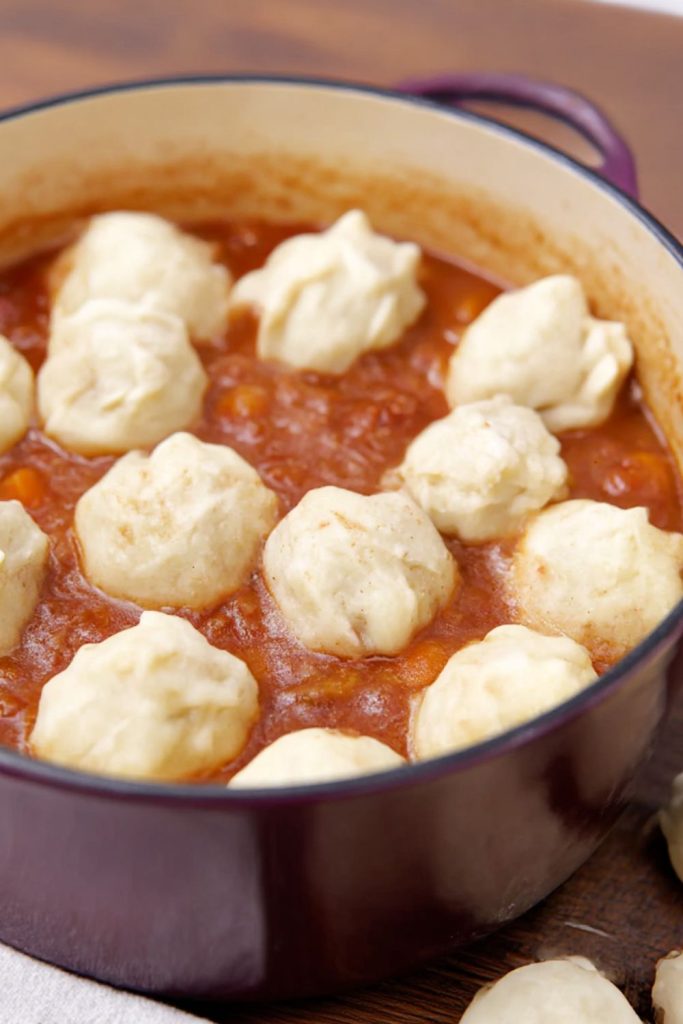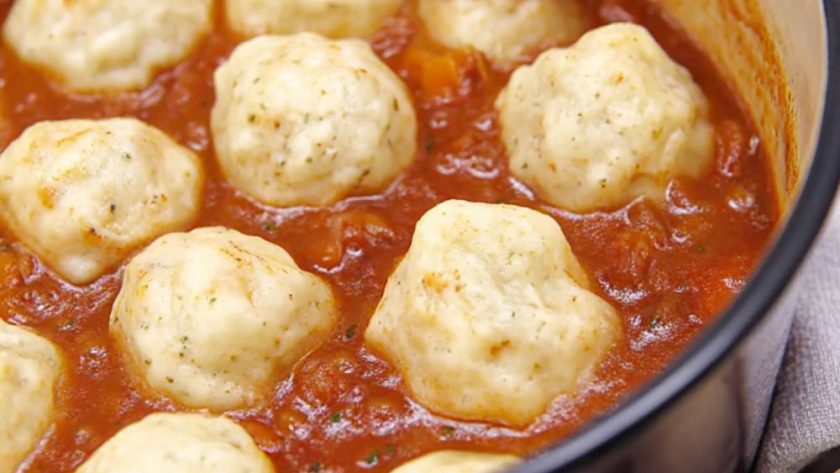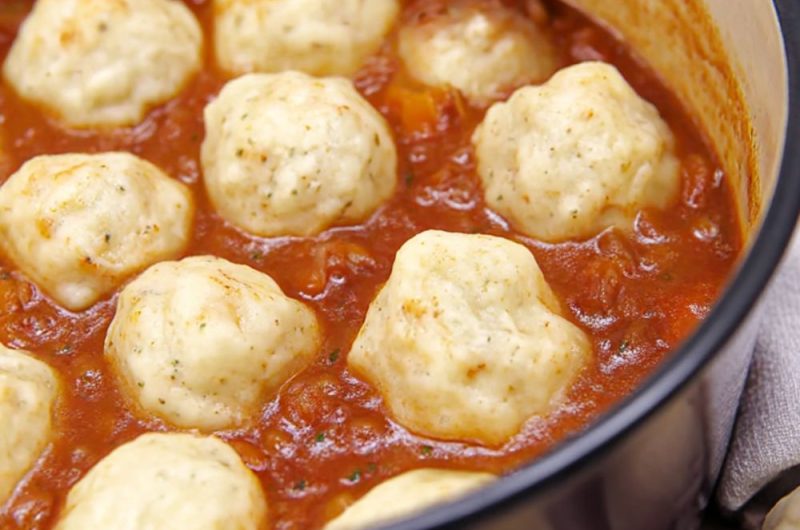This Dumplings recipe is a fluffy and light recipe, which is made with self-raising flour and cold butter. It’s the ultimate comfort food topping, perfect for any beef or chicken stew, ready in about 40 minutes.
Dumplings Ingredients
A simple, classic list for the perfect savory stew topping.
- 250g self-raising flour, plus extra for dusting
- 125g cold unsalted butter
- A pinch of sea salt and black pepper
- A splash of cold water
How To Make Dumplings
A step-by-step guide to these wonderfully simple and fluffy stew toppers.
- Prep the Dough: Place the self-raising flour in a mixing bowl. Using the coarse side of a box grater, grate the cold butter directly into the flour. Add a pinch of sea salt and black pepper.
- Combine and Form: Use your fingertips to gently rub the butter into the flour until the mixture resembles coarse breadcrumbs. Add just enough cold water (a splash at a time) to bind the mixture into a soft, but not sticky, dough.
- Shape the Dumplings: Divide the dough into 8 large or 12 smaller pieces and gently roll each one into a round dumpling.
- Cook and Serve: Uncover your simmering stew. If it looks dry, add a cup of boiling water. Place the dumplings on top of the bubbling stew, pressing them down lightly so they are half submerged. Immediately cover with a tight-fitting lid and cook for 30 minutes without lifting the lid. The dumplings can be cooked either in the oven with your stew (at 190°C/375°F) or on the hob over a medium heat.

Recipe Tips
For the lightest, fluffiest dumplings every time.
- How to get the lightest, fluffiest dumplings? The secrets are using very cold butter and not overworking the dough. Grating the frozen or very cold butter into the flour is a brilliant trick that keeps the butter in small pieces, which creates steam and makes the dumplings light and airy as they cook.
- Why can’t I peek while they’re cooking? It’s crucial to keep the lid on for the entire cooking time. The dumplings cook by steaming in the hot stew. Lifting the lid releases all the steam and can cause them to become heavy and dense instead of light and puffy.
- Can I add herbs? Yes, absolutely! Finely chopped fresh herbs are a classic and delicious addition. Try adding 1-2 tablespoons of chopped fresh parsley, thyme, or chives to the dry flour mixture for extra flavor.
- What if I don’t have self-raising flour? You can make your own by whisking 2 teaspoons of baking powder into every 150g (1 cup) of plain (all-purpose) flour. For this recipe, you would use 250g of plain flour and about 3 teaspoons of baking powder.
What To Serve With Dumplings
The perfect main courses for these comforting stew toppers.
These savory dumplings are the crowning glory of any hearty, slow-cooked meal. They are perfect for:
- A classic beef and vegetable stew
- A creamy chicken and mushroom casserole
- A rich lamb and root vegetable stew
- A hearty vegetarian bean and vegetable stew
How To Store Dumplings
These are best enjoyed immediately.
- Best Eaten Fresh: Dumplings are at their absolute best when they are fluffy and fresh, straight from the stew.
- Reheat: If you have leftovers, it’s best to store the stew and the dumplings in separate airtight containers in the refrigerator. Reheat the dumplings in a moderate oven or an air fryer for a few minutes to help them crisp up slightly before serving with the reheated stew.
Dumplings Nutrition Facts
An estimated guide per dumpling (if making 12).
- Calories: 150 kcal
- Carbohydrates: 15 g
- Protein: 3 g
- Fat: 9 g
Nutrition information is estimated and may vary based on ingredients and cooking methods used.
FAQs
What’s the difference between butter and suet in dumplings?
Suet is the traditional fat used in classic British dumplings, which gives them a very light and rich texture. Butter, as used in this recipe, is a fantastic and more readily available substitute that creates a slightly richer, softer, more scone-like dumpling.
My dumplings were dense and heavy. What did I do wrong?
Dense dumplings are usually the result of overworking the dough, which develops the gluten and makes them tough. Handle the dough as little as possible—just enough to bring it together. Another culprit can be peeking under the lid while they are steaming!
Can I make these gluten-free?
Yes. You can make these by substituting the self-raising flour with a good-quality gluten-free self-raising flour blend.
Try More Recipes:
- Crostini – greens Recipe
- Crostini – prosciutto, figs and mint Recipe
- Crostini – buffalo mozzarella and chilli Recipe
Dumplings Recipe
Course: DinnerCuisine: BritishDifficulty: Easy12
servings10
minutes30
minutes150
kcalClassic, light, and fluffy British-style dumplings made with butter instead of suet. They are incredibly easy to make and are the perfect savory topping to steam on top of any hearty stew.
Ingredients
250g self-raising flour
125g cold unsalted butter
Pinch of sea salt and black pepper
A splash of cold water
Directions
- In a mixing bowl, grate the cold butter directly into the self-raising flour. Add a pinch of salt and pepper.
- Use your fingertips to gently rub the butter into the flour until it resembles breadcrumbs.
- Add just enough cold water to bind the mixture into a soft dough. Do not over-knead.
- Divide the dough into 8-12 pieces and gently roll each one into a ball.
- Place the dumplings on top of your favorite simmering stew, pressing them down so they are half submerged.
- Immediately cover the pot with a tight-fitting lid.
- Cook for 30 minutes without lifting the lid, until the dumplings are puffed up and cooked through.
Notes
- Using very cold or even frozen butter is the secret to light and fluffy dumplings.
- It is crucial that you do not lift the lid while the dumplings are steaming, as this will make them heavy.
- For extra flavor, add 1-2 tablespoons of chopped fresh herbs like parsley or thyme to the flour mixture.
- Ensure your stew has plenty of bubbling liquid for the dumplings to properly steam in.

